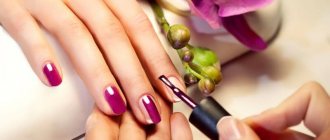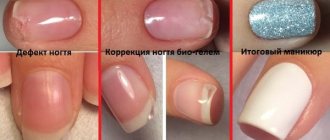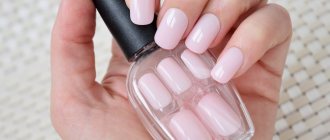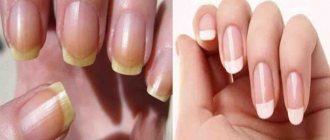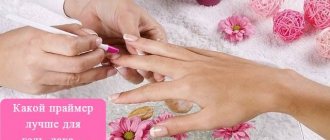Many have noticed, and some know, that the speed at which nails grow in men and women is different. There is no clear explanation for this. There is no consensus among experts when answering the question: why nail plates on the feet grow slower than on the hands. However, there are quite convincing theories that explain these facts.
Of course, a lot in these arguments depends on the state of health and external factors. But there is no significant difference in the growth rate of nail plates among residents of the North, compared to people living in the southern regions.
Nail growth rate
On average, the growth rate of nails is from 0.1 to 0.15 mm per day, respectively 3 - 4 mm per month. The nail completely changes in about six months, growing by 4 - 5 cm per year. Nails on your hands grow much faster than on your feet. So, with surgical removal, a new fingernail grows in 5 months, and on the toes in 14.
If you stop cutting your nails, their growth will not continue indefinitely. At some point, when they reach a certain length, their growth stops.
Nail plate shaped like a spoon
Concave nails in their central part are deformations caused by softening of the nail plate. The central dent is usually large enough to accommodate a drop of liquid.
Read also: The child does not eat meat. What to do?
Spoon nails are usually a sign of long-term iron deficiency in the body, that is, anemia. Coronary heart disease and hypothyroidism are other common causes of spoon-shaped nails (koilonychia).
Koilonychia
In infants, this type of nail usually returns to its normal shape over time and is not a sign of disease.
However, if such deformity exists only on the nails of the thumbs, it may be a sign of neurosis, manifested by obsessive movements of the other fingers over the surface of the thumb. With frequent movements of this type, mechanical damage to the nail plate occurs.
What does nail growth depend on?
- Women have a faster nail growth rate than men. It is believed that men cut 4 meters of nails, and women - 4.5 meters.
- Nails grow faster on the right hand of a right-handed person, and on the left hand of a left-handed person.
- In old age, the rate of nail growth decreases, which is associated with a decrease in the intensity of immunity and blood supply.
- On longer fingers (ring, index, middle) and people with long fingers, nails grow faster than people with short fingers.
- In summer, the growth rate is higher than in winter, higher during the day than at night, and higher in the morning than in the middle of the day.
Rules of care: how to grow nails quickly and easily
“There are several recommendations for strengthening and improving the appearance of nails,” comments Anna Shevchuk. — Daily application of cuticle oil shows a good effect. The oil composition nourishes and strengthens the base of the nail plate, and with this product you “kill” two birds with one stone. The nails will become stronger and grow faster. Plus, your hands will look well-groomed, since thanks to the oil, the cuticle becomes moisturized, healthy, and hangnails disappear.”
The expert advises changing your daily hand care routine.
- Use varnishes with vitamin complexes . They protect the nail plate, strengthen it and give it a well-groomed appearance. Such medicinal coatings should be chosen for hygienic manicure. But it is important to remember that their effect can be negated by nail polish remover with acetone. This substance has an aggressive effect on the nail plate, dries it out and makes it brittle. For regular use, choose nail polish remover without acetone.
- Do your manicure carefully and regularly . You can contact a nail service specialist or perform the care yourself. If you do not use the services of a master, choose the right tools and manicure techniques. Trim your nails using sharp nail scissors or nail clippers in a straight line, then carefully round off the edges with a nail file. The plate must be filed in strictly one direction - to the right or to the left. If you file in different directions, it will flake.
- Don't cut your nails too short . Always leave a few millimeters of white tip. This is the optimal length for rapid growth.
- Remove dirt from under your nails regularly as they appear. They can lead to fungal infections and damage to the nail bed.
Nails need to be periodically given a “rest” from any coating, leaving them clean and allowing them to “breathe”. Such a respite is useful for their recovery. Plan it for vacation, when the appearance of your hands is not as important as in the office.

pixabay.com/
Eliminating Side Effects
After the procedure, you may experience throbbing, pain, swelling, bleeding, discharge, and tenderness in the affected finger or toe. To help manage these side effects, follow these recommendations.
- For the first 48 hours after the procedure, elevate the affected arm or leg as high as possible above heart level. This will help reduce pain and swelling. For 1 week, try to keep the affected arm or leg elevated as often as possible.
- If you experience bleeding, press a clean gauze pad firmly onto the wound for 15 minutes. If the bleeding has not stopped after 15 minutes, apply firm pressure to the wound for another 15 minutes. If the bleeding still doesn't stop, call your doctor.
- If desired, you can take acetaminophen (Tylenol®) or extra strength acetaminophen (Extra Strength Tylenol®) to relieve pain or discomfort. Do not take aspirin or nonsteroidal anti-inflammatory drugs (NSAIDs) such as ibuprofen (Advil®) or naproxen (Aleve®). These medications may increase bleeding. Follow dosage directions on the package. If the recommended dosage does not relieve pain, call your doctor.
- If you are allergic to acetaminophen or have a medical condition that prevents you from taking it, ask your healthcare professional what medicine you can take instead.
- If you are participating in a clinical trial for cancer treatment, ask your oncologist (cancer treatment doctor) what pain medications you may take.
to come back to the beginning
Why is nail fungus difficult to treat?
Onychomycosis (fungal infection of the nail plate) is very difficult to treat in all people. There are three reasons for this:
- The microbe gets into the nail bed and not all local drugs can reach it. Moreover, most fungi provide themselves with “protection” in the form of thickening of the nail plate.
- In most cases, onychomycosis is accompanied by a fungal infection of the foot. And as soon as a person cures his nails, the fungus again enters the nail bed from the skin of the foot.
- Re-infection also occurs through one’s own socks, shoes, and also when bathing in a bath/shower.
Before the procedure
- Buy special bandages for your fingers or toes. You will need to use them after the procedure. You can buy them at your nearest pharmacy.
- If the procedure will involve your toes, you may want to bring open-toed shoes to wear after the procedure.
- If you drive to your appointment, please have someone with you who can drive you home after your appointment.
The evening before the procedure or the morning of the procedure, take a shower. You can eat and take all medications as usual.
to come back to the beginning
What do nails look like after treating fungus?
In the first 2-3 months from the start of using local drugs, the nail plate will not yet change noticeably. The fungi remaining in the subungual space continue to multiply, and thickening or, conversely, thinning again forms on the nail. The growing plate retains its pathological color for some time: yellow, milky white, black or brown. It may still be scaly, ribbed or curved. There may be chips on it, or an area where it moves away from its bed.
When treated with tablets, pathological changes in the growing nail plate can be observed for less than two months. Then, after treating the fungus, the area of the nail closest to the hole should take on a healthy appearance:
- become smooth;
- change color to pinkish or reddish, uniform in color;
- acquire normal thickness. If the nail grows back after removing the entire nail plate, it has the right to be a little thinner. This is also an indicator of his health.
If, despite treatment, after 2-3 months the nails remain altered in color, thickness or smoothness, then the therapy must be reviewed.
What to expect during the procedure
About 5 to 10 minutes before the procedure, your doctor or nurse will give you an injection (shot) of a local anesthetic (medicine that will numb the area) near the affected nail(s). You will also have the affected area cleaned with medicinal soap or alcohol.
After numbing the area, your doctor will remove part of the nail plate or the entire nail plate.
After removing the nail, your doctor or nurse will cover the wound with antibiotic ointment. Your doctor may also give you a prescription for an antibiotic to take at home.
to come back to the beginning
Isolated acquired onychodystrophies
The category of isolated onychodystrophies includes those that occur independently without connection with other diseases. Most often they are the result of adverse mechanical, chemical and ultraviolet effects. These include increased fragility of nails, the formation of longitudinal grooves, onycholysis and others. In general, they cause only a cosmetic defect and do not pose a danger. To restore the health of the nails (with rare exceptions) in such situations, it is enough to eliminate the cause of the development of onychodystrophy.
Brittle nails
Increased fragility of nails is the most common type of onychodystrophy, which consists in breaking off the free edge of the nail plate along the entire thickness. In most cases, women face a similar problem due to the depletion of their nails by frequent manicures, especially those carried out in violation of the rules, or frequent contact with hot water or chemicals.
Call your doctor if you have:
- temperature 100.4°F (38°C) or higher;
- chills;
- any of the following symptoms in or around the wound: increasing redness or swelling of the tip of a finger or toe;
- increasing pain or discomfort;
- skin that is hard, warm, or hot to the touch;
- bright yellow or green discharge;
- unpleasant odor from the skin or nails;
- bleeding that does not stop after pressing the napkin;
- discoloration of the tip of a finger or toe to blue or purple;
to come back to the beginning
Classic types of treatment for onychomycosis
Currently, medicine uses three main approaches to treating nail fungus:
- Systemic drugs in the form of tablets or capsules. They can help, but for this they need to be taken over a long course - from 4 to 18 months. All these medications are toxic to the liver; taking them can be complicated by the development of diarrhea, skin rashes, and changes in taste. Therefore, during treatment you need to strictly follow a therapeutic diet, stop drinking alcohol and periodically take blood tests - “liver tests”.
- Local remedies (creams, varnishes). They do not always penetrate the nail plate well. Therefore, it must be prepared in advance: cut off the overgrown masses of the nail with clippers or remove it using a cutter. You cannot do this on your own: you can damage the cells that give rise to the nail plate.
- Combination therapy: simultaneous administration of a systemic drug and application of a local antifungal agent to the affected nail. It is used in severe cases to slightly minimize the severity of side effects from systemic drugs. The effectiveness of such treatment is also not very high.
In some cases, dermatologists remove the affected nail plate before prescribing topical treatment. Now they are trying to do this less and less, limiting themselves only to filing off the affected area - in order to avoid infection of the nail bed with bacteria.
It would seem that onychomycosis can be left untreated, but in fact it represents something more than an aesthetic defect. It can lead to a severe mixed (fungal and bacterial) infection of the foot or hand, which can even lead to gangrene.
How can you speed up the treatment of onychomycosis?
To make nails grow back faster after fungus treatment, laser therapy can be used. It involves treating the nail plate with a PinPointe device - a neodymium laser with a wavelength of 1064 nm. Its radiation freely penetrates the nail bed and there heats the fungal cells to high temperatures, as a result of which they die. In addition, the heat from the laser activates blood circulation in the nail bed, which accelerates the growth of a healthy nail plate.
The PinPointe laser is used in conjunction with local therapy. After a laser treatment session, the patient should apply the recommended cream or varnish to the nails, and also carefully treat the shoes with an antiseptic to avoid re-infection.
The effectiveness of treating onychomycosis with the PinPointe neodymium laser has been tested in several foreign multicenter studies. This is an excellent addition to local treatment, has a short procedure duration and is not accompanied by side effects.
Thus, a healthy nail plate should begin to grow in the first months from the start of treatment. It may be slightly thinner than usual, but have a uniform pinkish color and smoothness. The treatment process is significantly accelerated when treating the affected plates with a PinPointe neodymium laser.

